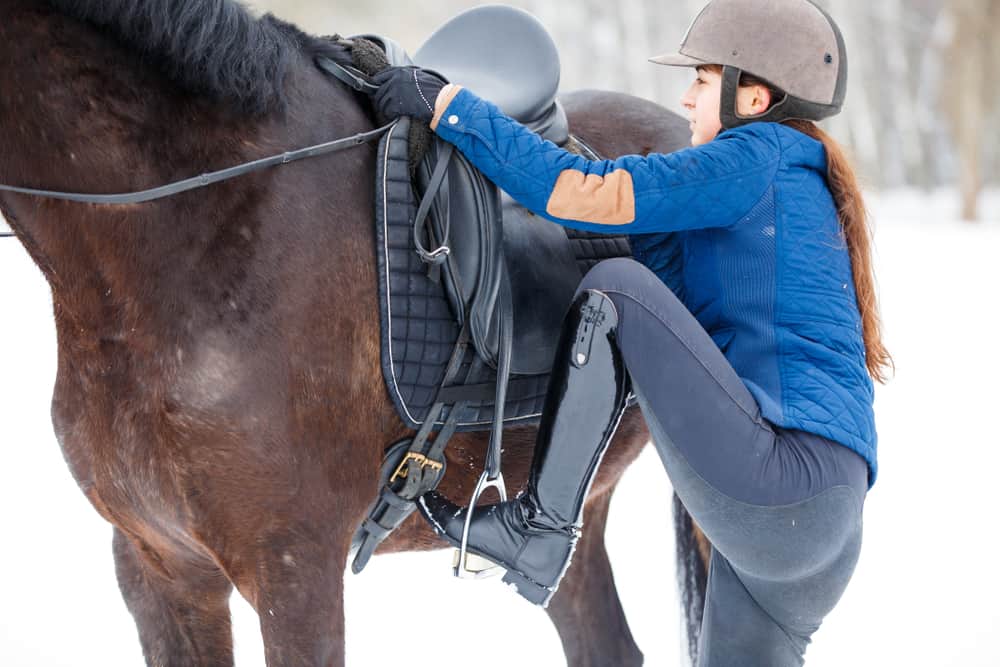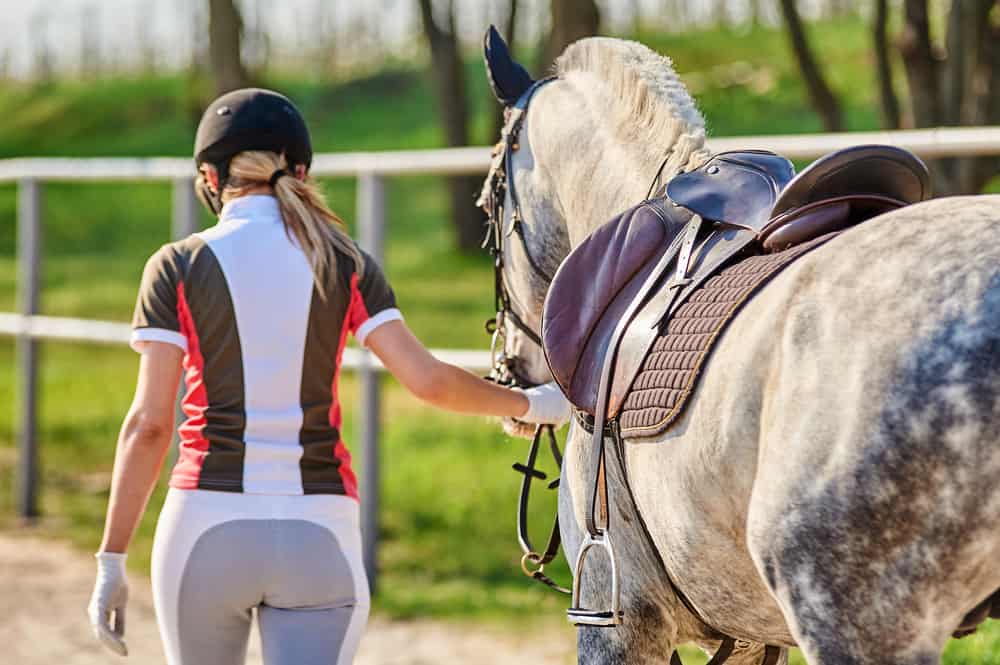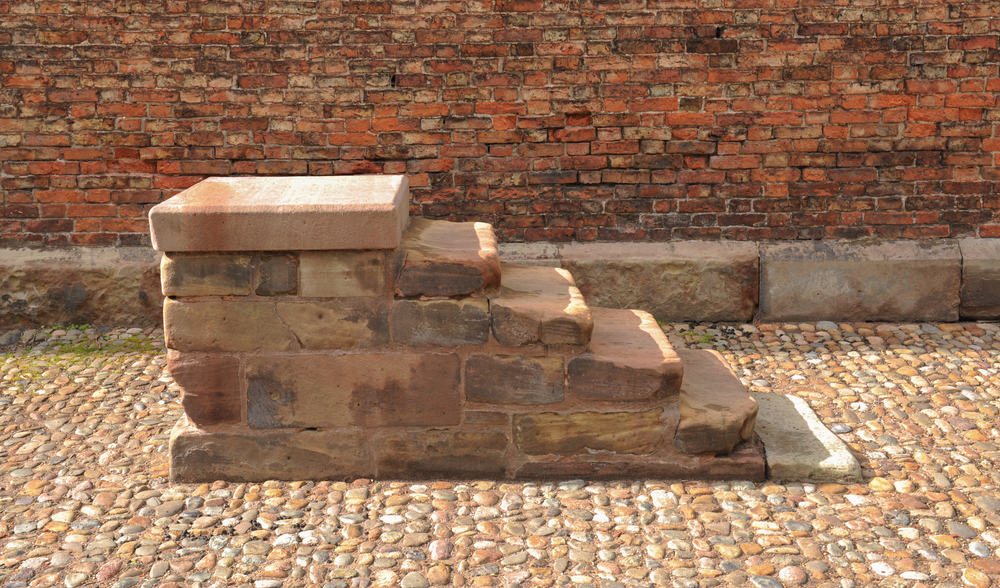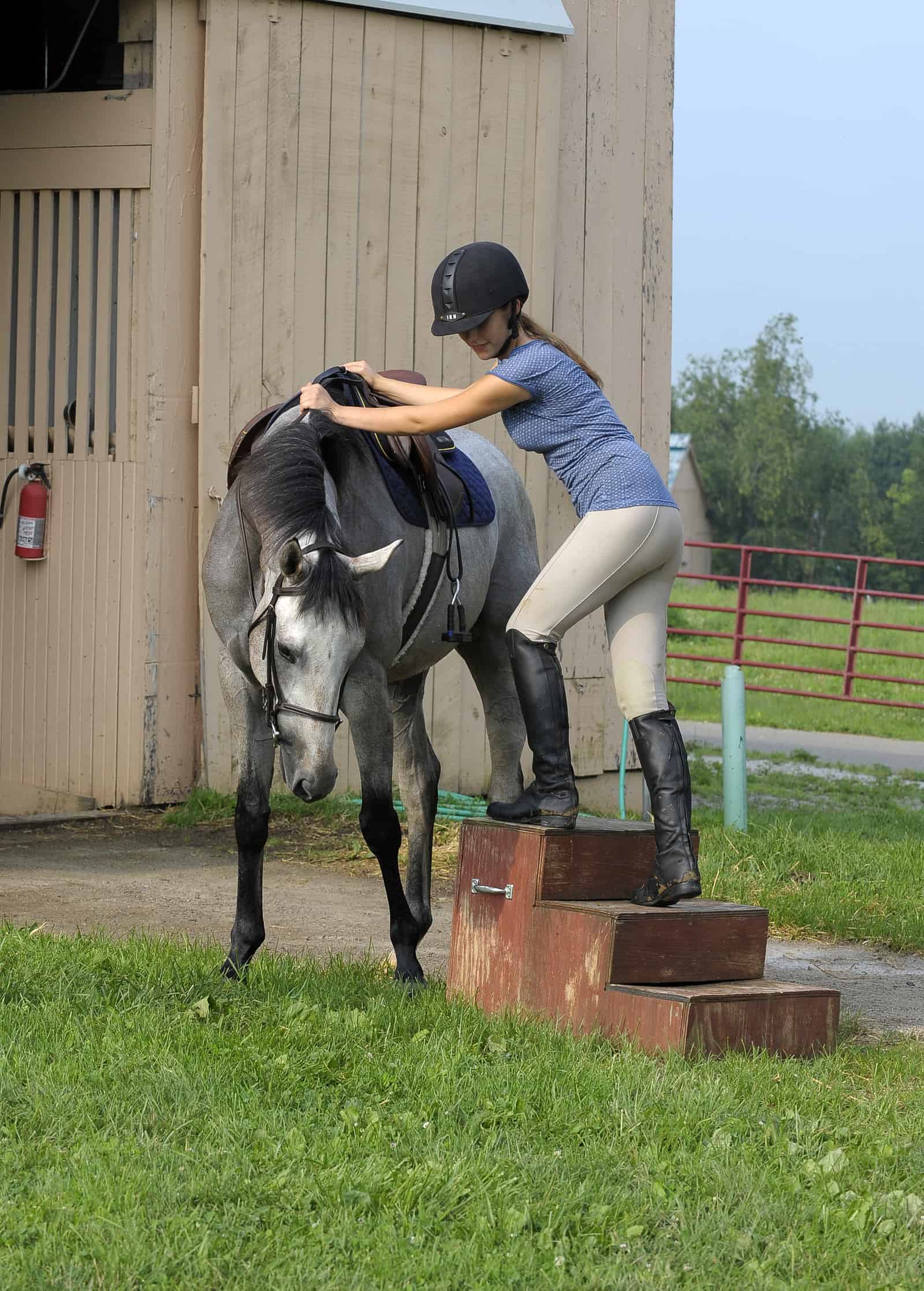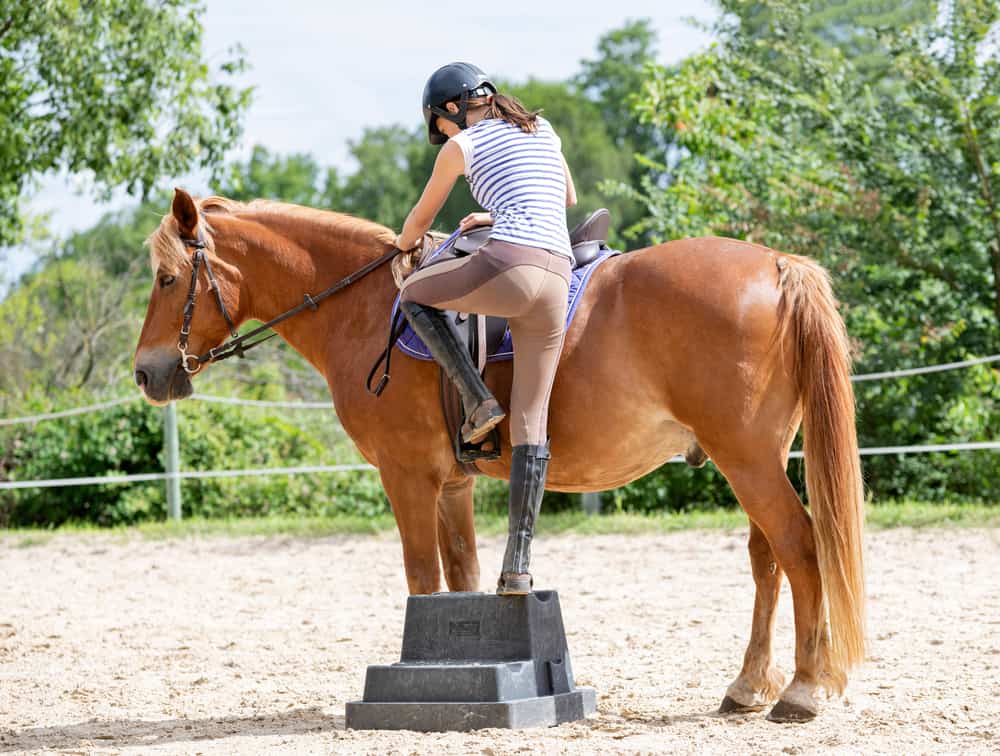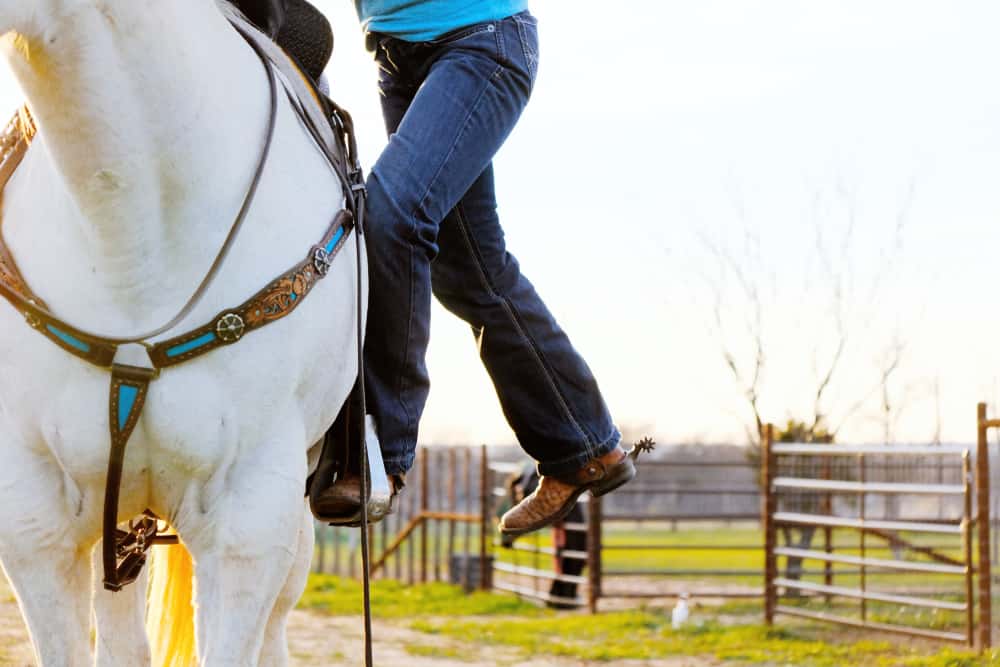When you go for horse riding classes, one of the first things that you learn is to mount a horse. A good mount not only makes the animal feel safe but also allows you to properly control them.
At first glance, getting on a horse may seem easy, but there are several things a rider needs to pay attention to like positioning the horse, which side to mount from, holding the reins, etc.
Keep reading to learn how to mount a horse and get pointers to make your first time fun, safe, and comfortable both for you and the horse.
Step-by-Step Guide on How to Safely Get On a Horse
Horses are traditionally mounted from the left, but with continued practice, you should be able to get on from the right side as well. Below are 5 steps to follow to ensure a safe mount.
Step 1: Lead the Horse to the Mounting Area
The first thing you need to do is move your equine out to a flat ground. Ensure the area is not overcrowded, as this could spook the animal.
While at it, make sure the left side is clear, as this is the side you will be getting on from. As days go by, however, it’s important that you learn how to mount from both sides. Not only does it improve your riding; it can also keep you safe if you find yourself in a dangerous situation.
Step 2: Position Your Mounting Block (Optional)
A mounting block is not really a necessity when mounting a horse, but it can make it easy for you to reach the stirrups. Also, constantly getting on a horse without a mounting aid puts quite an amount of strain on the animal’s back; a mounting block minimizes that strain and protects the animal’s back.
If you will be using one, move it closer to the horse such that it rests just below the stirrup you will be using to climb up.
Step 3: Move Closer to the Horse
Whether you are starting your mount from a block or from the ground, make sure you are standing next to your horse’s front leg. Because you are mounting from the left, position yourself next to the animal’s left leg.
Standing closer to the front leg of the side you will be climbing from makes it easier for you to reach the stirrup without losing control of the horse.
But you also want to make sure that the horse is focused on you and they aren’t trying to escape. To do this, lay the reins over the horse’s head so they will be positioned properly when you climb. Then grip the reins as you mount to keep the animal still.
When you are just getting started with horse mounting, it’s wise to ask someone to hold the equine for you while you climb.
Step 4: Place Your Leg In the Stirrup
Holding the reins tight, lift your left leg and put it in the stirrup. This will be much easier to do with a mounting block; because your foot will be nearer to the stirrup, you will not have to raise your leg or body a long distance to get to the back of the horse.
Now, shift your weight onto the left foot and swing your right leg above the horse, with your left hand gripping the reins; some people also grab the saddle pommel. Do not grab the back of your horse’s saddle, as it could make the saddle slip. Also, it’s important that you watch how your leg swings over the top to avoid kicking or bumping the horse.
Step 5: Slowly Sit on the Saddle
With both of your feet now in the stirrups, gently sit on the saddle. You don’t want to land hard or you will hurt the animal’s back.
Having your feet placed in the stirrups before landing in the saddle gives you control over your muscle, making it easier for you to sit and protecting your horse’s back.
Once you have properly sunk into the saddle, slightly adjust your girth and posture to what you feel the most comfortable. If you need to adjust the length of the stirrups too, now it’s the time. Check out this video on how to achieve the correct riding posture.
After you have positioned yourself appropriately, properly grip the reins in your hands and signal the horse to start moving, and you are ready to go.
How to Ensure a Safe and Comfortable Mount
Safety should be your number one priority, so before you mount, make sure to do the following:
Wear Safety Gear
Invest in safety equipment designed for horse riding. For instance, get a pair of boots with a small heel so your feet remain in the stirrups. You will also want to get a helmet that is ASTM or SEI certified to keep your head protected in case of a fall.
But you are probably wondering – can you wear a helmet for other sports?
You sure can, but it won’t protect you as well as one made specifically for horse riding. You don’t want to ride in flat canvas either, as these will keep your feet sliding off the stirrups.
Inspect Your Horse’s Girth
You see that part of the saddle that goes around the horse’s chest? That’s the girth and it’s what holds the saddle in place. Before you hop onto the horse, you want to make sure the girth is tight enough so the saddle doesn’t move and drops you to the ground.
However, you don’t want it too tight that it interferes with the animal’s movement. If the space between the girth and the equine’s side can fit two fingers, then you should be good.
It’s important, however, to note that horses usually don’t like the girth and you will see them puff up their chests to loosen it whenever you try to tighten it. So, even if you adjust the girth before mounting, you will still need to check it again after you have started the ride to make sure it is still tight enough.
Adjust the Length of Your Stirrups
Even though you can do this after you have sat on the saddle, adjusting stirrups is always much easier to do while you are on the ground. Not only does it give you the foundation length you need to mount the horse; it also allows you to effectively control your leg muscle while you sink into the saddle to avoid harming the animal.
Warm Up Your Horse
Naturally, horses perceive anything climbing on their back as a predator and they can easily get spooked, especially if they haven’t had someone ride them for a while.
You don’t want to scare your horse by jumping on their back right away. Make them feel relaxed by walking them around the mounting area. You may also talk to them so you can both connect mentally. This will go a long way in calming the animal and ensuring a safe mount.
Why You Should Learn to Get On a Horse From Both Sides
There are numerous reasons why a rider should mount their horse from both sides. Perhaps the most common one relates to the animal’s muscle development.
If you are only climbing your horse, say from the left, the equine will have problems with their back muscle. Because the animal is repeatedly working the left muscles of their spine to support your weight, those muscles will become larger, stronger, and tighter, and this can affect how well they perform and how well the saddle fits on their back.
When you alternate the sides you mount from, the horse uses their back muscles uniformly, which helps prevent back problems.
This approach of mounting a horse can also come in handy when you need to avoid danger, particularly in trail riding.
It also prevents one stirrup leather from stretching and becoming longer than the other. Because both stirrups will be subjected to equal weight, the leathers will stretch uniformly so that over time both will become longer and you will not end up with unbalanced stirrups.
If your horse has never been mounted from both sides before, introduce the technique gradually. If they have only be mounted from the left, for instance, start by first leading and handling them from the right. But before you try anything, make sure the animal is comfortable with you mounting from either side.
The Takeaway
Knowing how to properly mount a horse prevents accidents that may result from carelessly bumping or kicking the horse. You can either use a mounting block or start from the ground, but a block makes things easier because it gets you closer to the stirrups.
And don’t forget to wear safety riding equipment, warm the horse up, and adjust the girth and stirrups before you start. It will help make both mounting and riding safe. Once you have mastered mounting from one side, learn how to climb from the other; it will help protect your horse’s back.
